side TOYOTA AYGO X 2022 (in English) Owner's Manual
[x] Cancel search | Manufacturer: TOYOTA, Model Year: 2022, Model line: AYGO X, Model: TOYOTA AYGO X 2022Pages: 494, PDF Size: 92.53 MB
Page 44 of 494
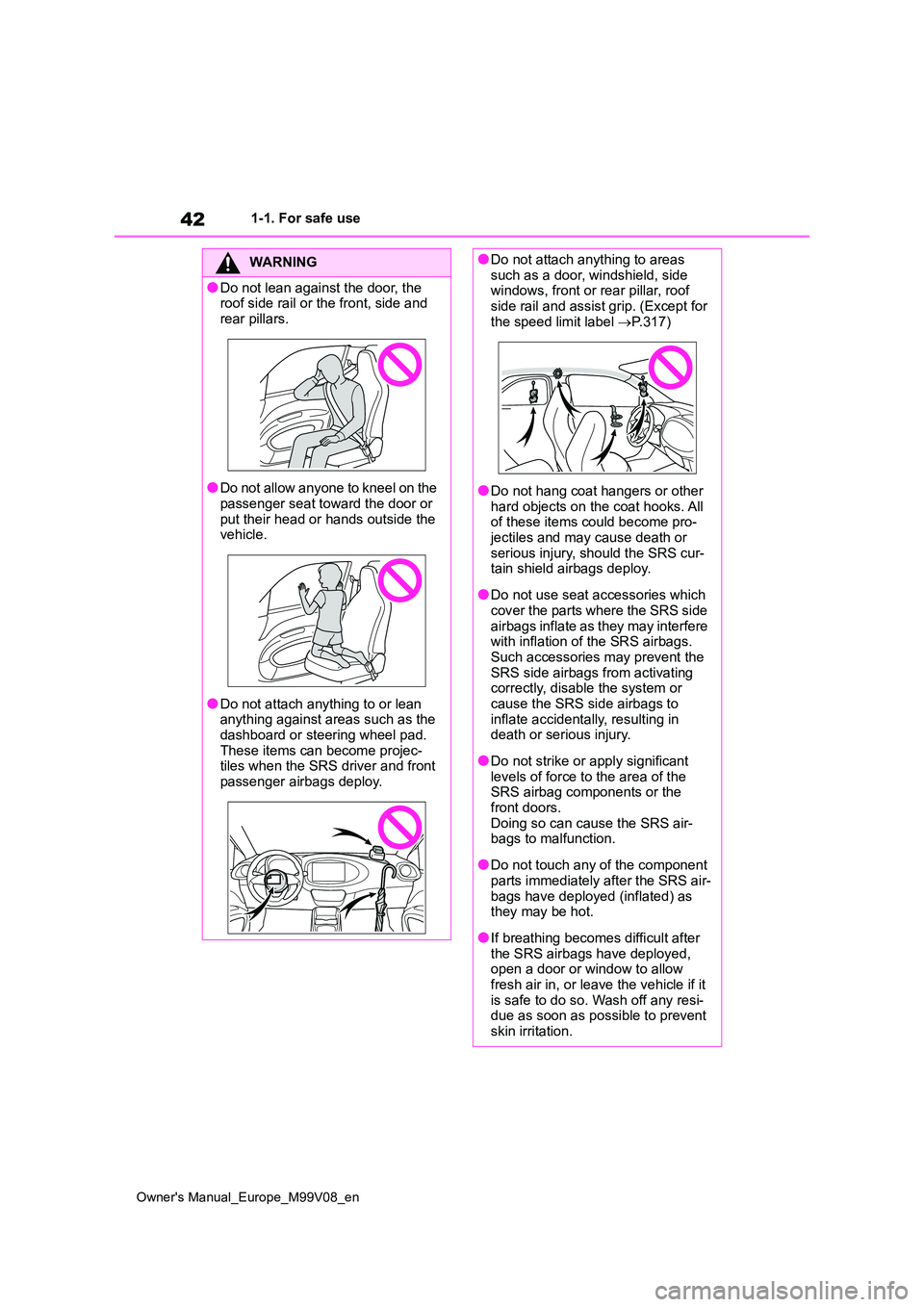
42
Owner's Manual_Europe_M99V08_en
1-1. For safe use
WARNING
●Do not lean against the door, the roof side rail or the front, side and
rear pillars.
●Do not allow anyone to kneel on the
passenger seat toward the door or put their head or hands outside the vehicle.
●Do not attach anything to or lean anything against areas such as the
dashboard or steering wheel pad. These items can become projec-tiles when the SRS driver and front
passenger airbags deploy.
●Do not attach anything to areas such as a door, windshield, side windows, front or rear pillar, roof
side rail and assist grip. (Except for the speed limit label P.317)
●Do not hang coat hangers or other hard objects on the coat hooks. All of these items could become pro-
jectiles and may cause death or serious injury, should the SRS cur-tain shield airbags deploy.
●Do not use seat accessories which cover the parts where the SRS side
airbags inflate as they may interfere with inflation of the SRS airbags. Such accessories may prevent the
SRS side airbags from activating correctly, disable the system or cause the SRS side airbags to
inflate accidentally, resulting in death or serious injury.
●Do not strike or apply significant levels of force to the area of the SRS airbag components or the
front doors. Doing so can cause the SRS air-bags to malfunction.
●Do not touch any of the component parts immediately after the SRS air-
bags have deployed (inflated) as they may be hot.
●If breathing becomes difficult after the SRS airbags have deployed, open a door or window to allow
fresh air in, or leave the vehicle if it is safe to do so. Wash off any resi-due as soon as possible to prevent
skin irritation.
Page 45 of 494
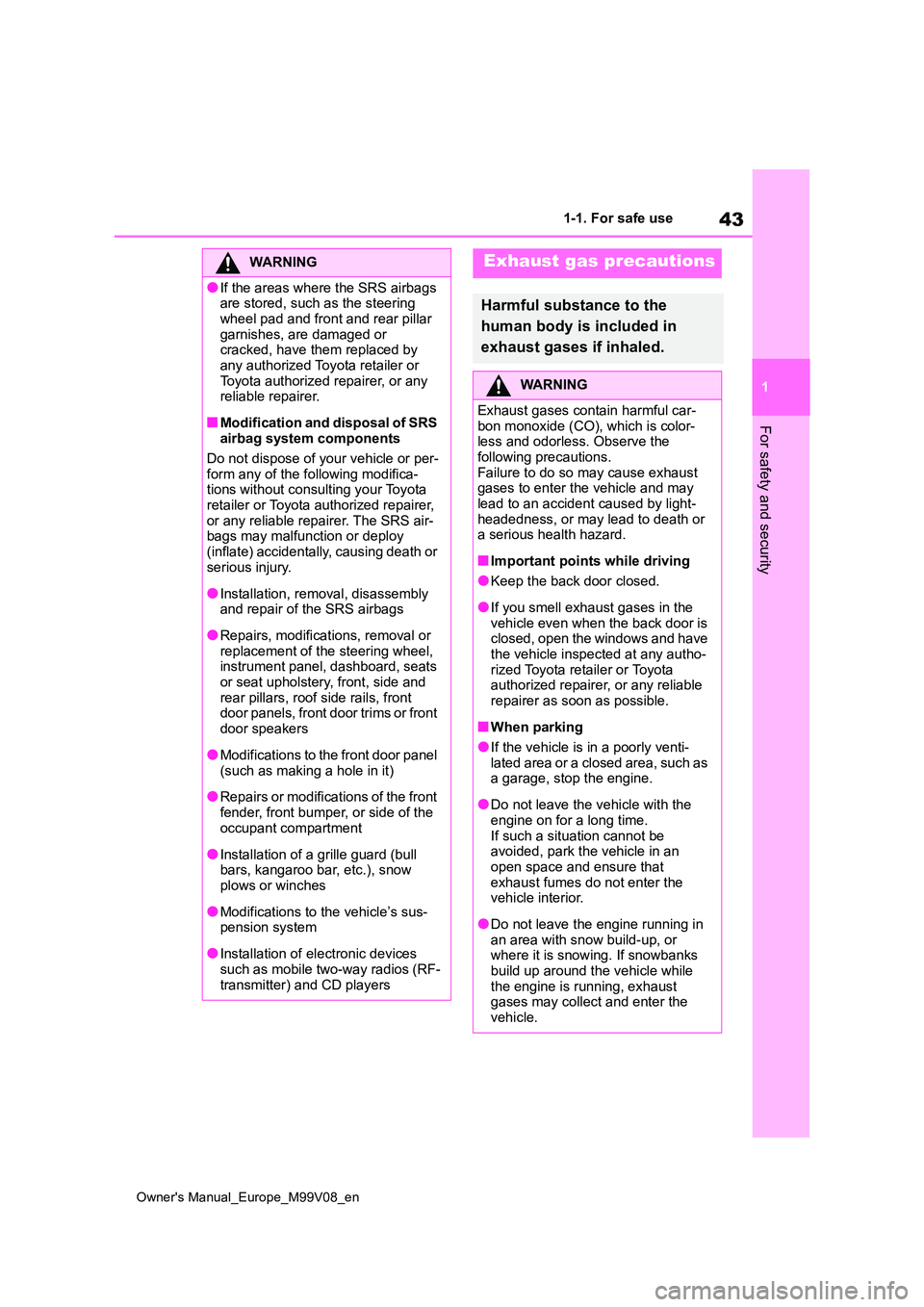
43
1
Owner's Manual_Europe_M99V08_en
1-1. For safe use
For safety and security
WARNING
●If the areas where the SRS airbags are stored, such as the steering
wheel pad and front and rear pillar garnishes, are damaged or cracked, have them replaced by
any authorized Toyota retailer or Toyota authorized repairer, or any reliable repairer.
■Modification and disposal of SRS airbag system components
Do not dispose of your vehicle or per- form any of the following modifica-tions without consulting your Toyota
retailer or Toyota authorized repairer, or any reliable repairer. The SRS air-bags may malfunction or deploy
(inflate) accidentally, causing death or serious injury.
●Installation, removal, disassembly and repair of the SRS airbags
●Repairs, modifications, removal or replacement of the steering wheel, instrument panel, dashboard, seats
or seat upholstery, front, side and rear pillars, roof side rails, front door panels, front door trims or front
door speakers
●Modifications to the front door panel
(such as making a hole in it)
●Repairs or modifications of the front
fender, front bumper, or side of the occupant compartment
●Installation of a grille guard (bull bars, kangaroo bar, etc.), snow plows or winches
●Modifications to the vehicle’s sus-pension system
●Installation of electronic devices such as mobile two-way radios (RF-
transmitter) and CD players
Exhaust gas precautions
Harmful substance to the
human body is included in
exhaust gases if inhaled.
WARNING
Exhaust gases contain harmful car-
bon monoxide (CO), which is color- less and odorless. Observe the following precautions.
Failure to do so may cause exhaust gases to enter the vehicle and may lead to an accident caused by light-
headedness, or may lead to death or a serious health hazard.
■Important points while driving
●Keep the back door closed.
●If you smell exhaust gases in the vehicle even when the back door is closed, open the windows and have
the vehicle inspected at any autho- rized Toyota retailer or Toyota authorized repairer, or any reliable
repairer as soon as possible.
■When parking
●If the vehicle is in a poorly venti- lated area or a closed area, such as a garage, stop the engine.
●Do not leave the vehicle with the engine on for a long time.
If such a situation cannot be avoided, park the vehicle in an open space and ensure that
exhaust fumes do not enter the vehicle interior.
●Do not leave the engine running in an area with snow build-up, or where it is snowing. If snowbanks
build up around the vehicle while the engine is running, exhaust gases may collect and enter the
vehicle.
Page 49 of 494
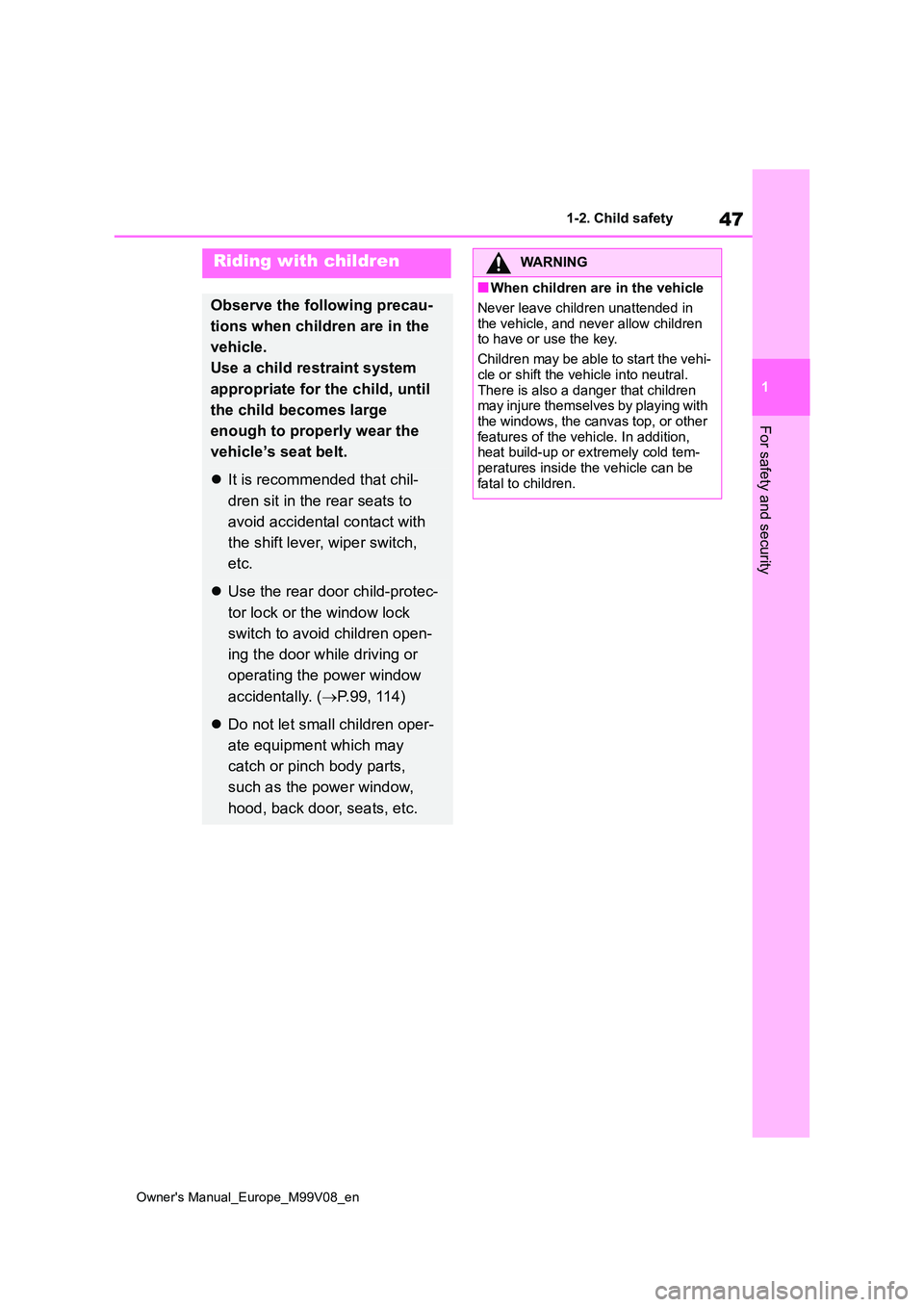
47
1
Owner's Manual_Europe_M99V08_en
1-2. Child safety
For safety and security
Riding with children
Observe the following precau-
tions when children are in the
vehicle.
Use a child restraint system
appropriate for t he child, until
the child becomes large
enough to properly wear the
vehicle’s seat belt.
It is recommended that chil-
dren sit in the rear seats to
avoid accidental contact with
the shift lever, wiper switch,
etc.
Use the rear door child-protec-
tor lock or the window lock
switch to avoid children open-
ing the door while driving or
operating the power window
accidentally. ( P.99, 114)
Do not let small children oper-
ate equipment which may
catch or pinch body parts,
such as the power window,
hood, back door, seats, etc.
WARNING
■When children are in the vehicle
Never leave children unattended in
the vehicle, and never allow children to have or use the key.
Children may be able to start the vehi-
cle or shift the vehicle into neutral. There is also a danger that children may injure themselves by playing with
the windows, the canvas top, or other features of the vehicle. In addition, heat build-up or extremely cold tem-
peratures inside the vehicle can be fatal to children.
Page 52 of 494
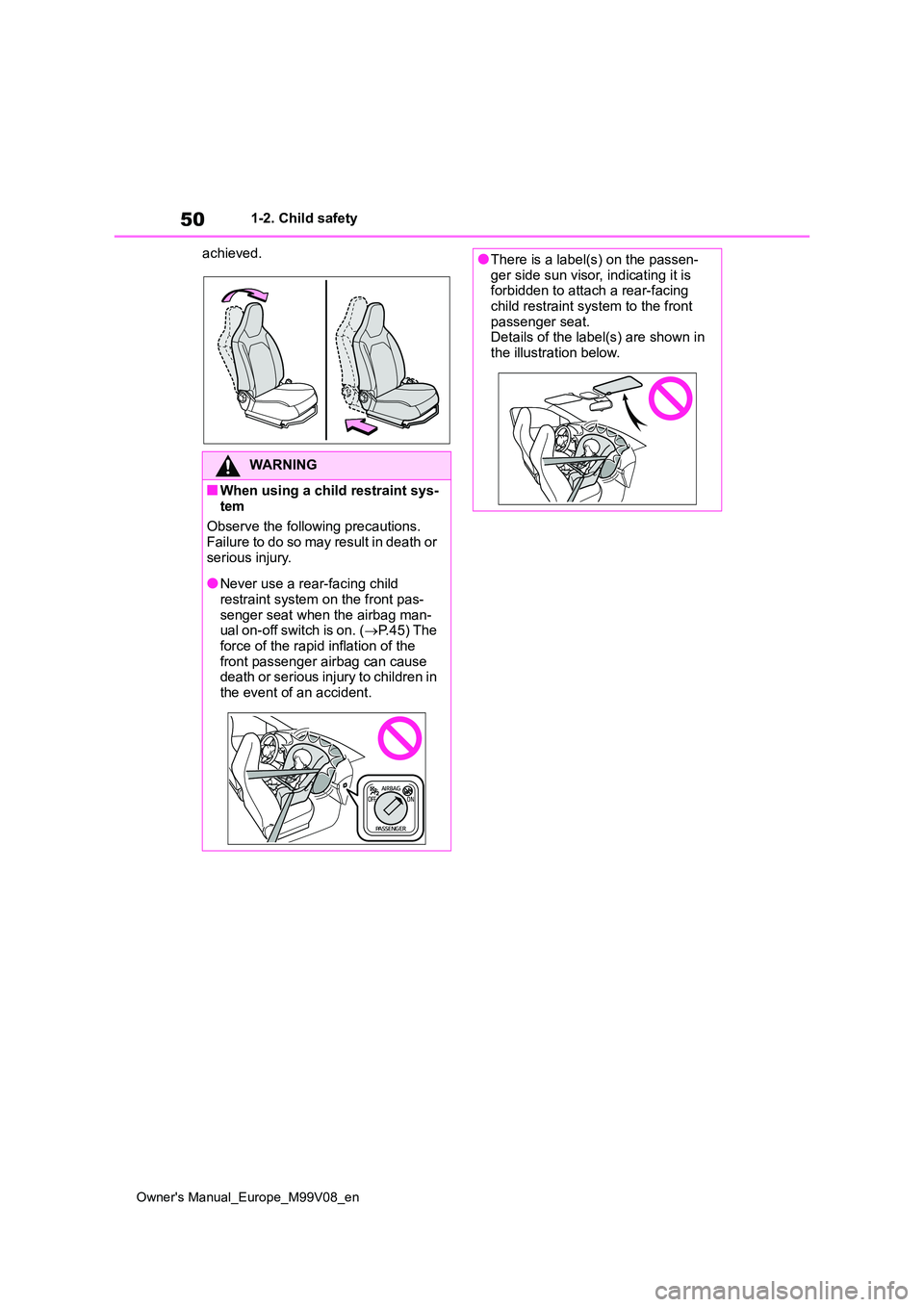
50
Owner's Manual_Europe_M99V08_en
1-2. Child safety
achieved.
WARNING
■When using a child restraint sys-
tem
Observe the following precautions. Failure to do so may result in death or
serious injury.
●Never use a rear-facing child
restraint system on the front pas- senger seat when the airbag man-ual on-off switch is on. ( P.45) The
force of the rapid inflation of the front passenger airbag can cause death or serious injury to children in
the event of an accident.
●There is a label(s) on the passen- ger side sun visor, indicating it is forbidden to attach a rear-facing
child restraint system to the front passenger seat.Details of the label(s) are shown in
the illustration below.
Page 53 of 494
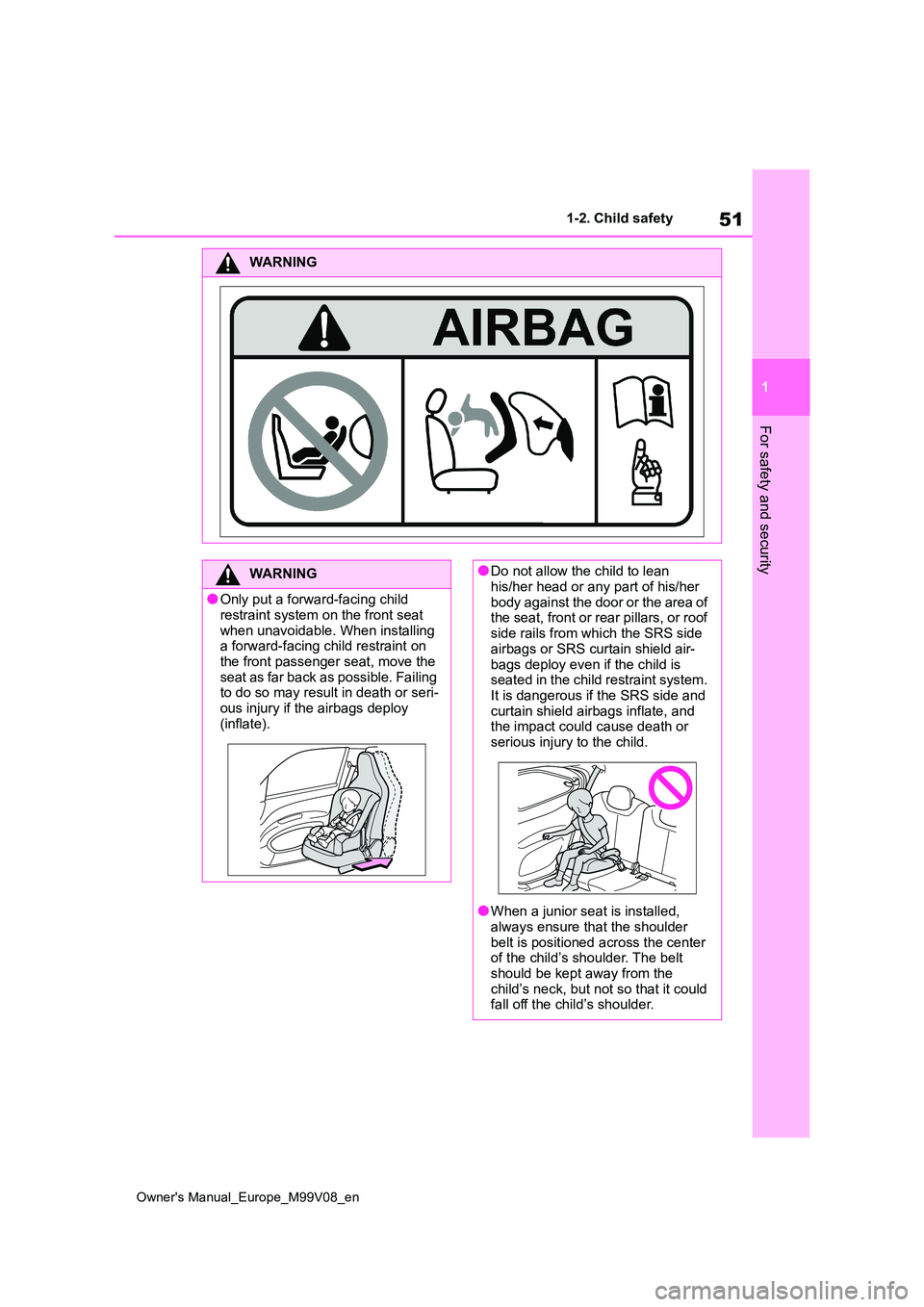
51
1
Owner's Manual_Europe_M99V08_en
1-2. Child safety
For safety and security
WARNING
WARNING
●Only put a forward-facing child restraint system on the front seat
when unavoidable. When installing a forward-facing child restraint on the front passenger seat, move the
seat as far back as possible. Failing to do so may result in death or seri-ous injury if the airbags deploy
(inflate).
●Do not allow the child to lean
his/her head or any part of his/her body against the door or the area of the seat, front or rear pillars, or roof
side rails from which the SRS side airbags or SRS curtain shield air-
bags deploy even if the child is seated in the child restraint system. It is dangerous if the SRS side and
curtain shield airbags inflate, and the impact could cause death or serious injury to the child.
●When a junior seat is installed, always ensure that the shoulder
belt is positioned across the center of the child’s shoulder. The belt should be kept away from the
child’s neck, but not so that it could fall off the child’s shoulder.
Page 55 of 494
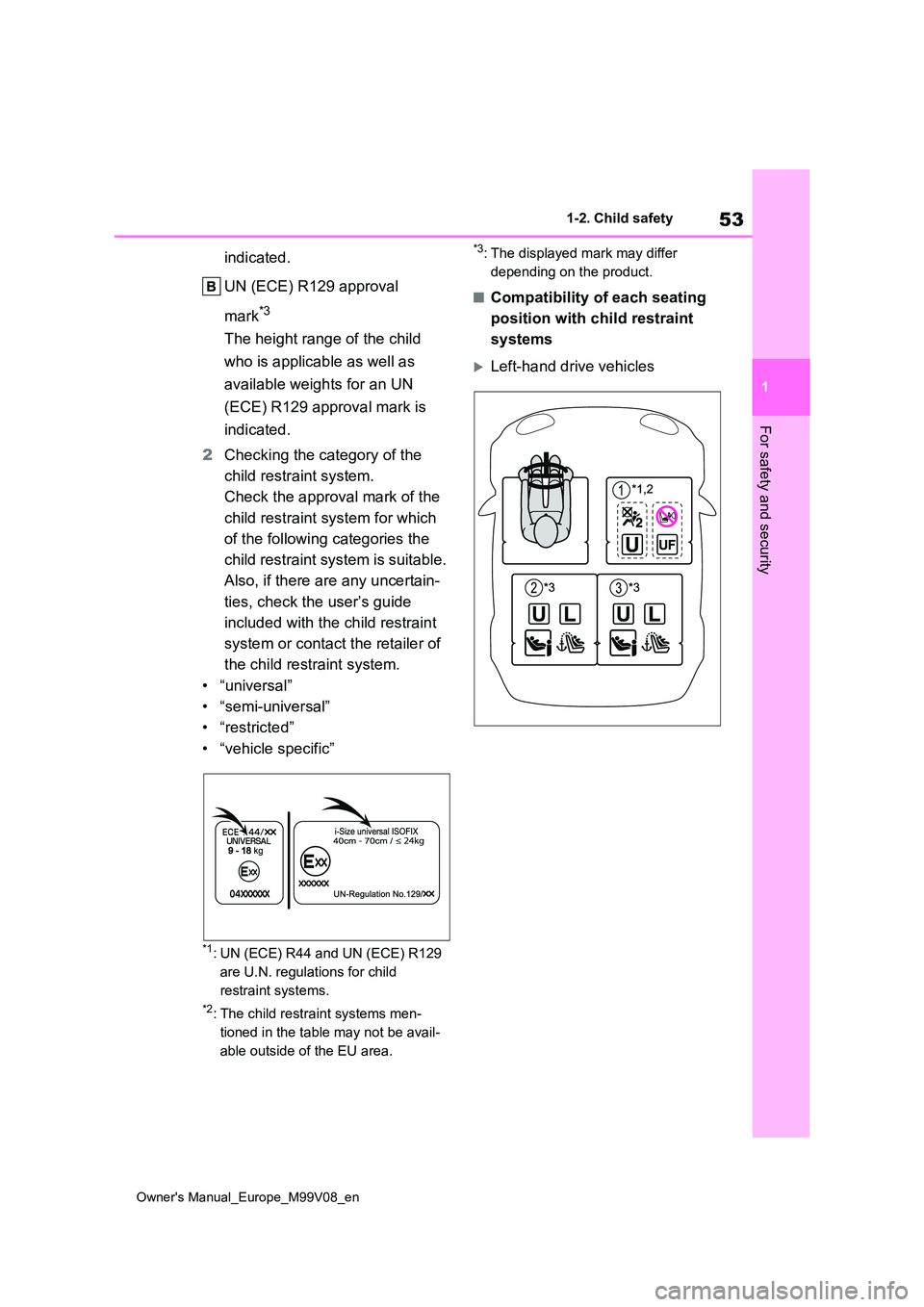
53
1
Owner's Manual_Europe_M99V08_en
1-2. Child safety
For safety and security
indicated.
UN (ECE) R129 approval
mark*3
The height range of the child
who is applicable as well as
available weights for an UN
(ECE) R129 approval mark is
indicated.
2 Checking the category of the
child restraint system.
Check the approval mark of the
child restraint system for which
of the following categories the
child restraint system is suitable.
Also, if there are any uncertain-
ties, check the user’s guide
included with the child restraint
system or contact the retailer of
the child restraint system.
•“universal”
• “semi-universal”
• “restricted”
• “vehicle specific”
*1: UN (ECE) R44 and UN (ECE) R129
are U.N. regulations for child
restraint systems.
*2: The child restraint systems men-
tioned in the table may not be avail-
able outside of the EU area.
*3: The displayed mark may differ
depending on the product.
■Compatibility of each seating
position with child restraint
systems
Left-hand drive vehicles
Page 59 of 494
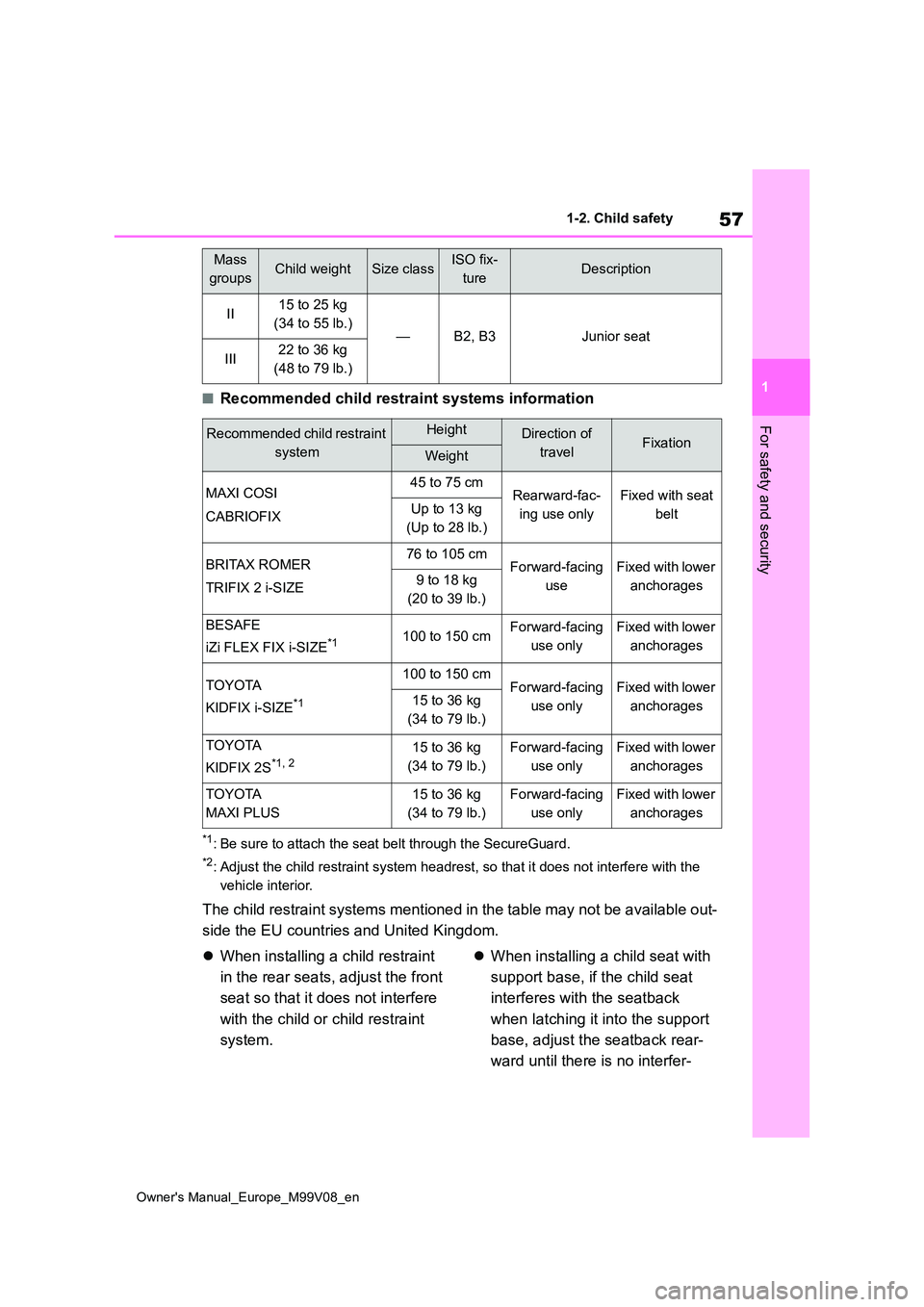
57
1
Owner's Manual_Europe_M99V08_en
1-2. Child safety
For safety and security
■Recommended child restraint systems information
*1: Be sure to attach the seat belt through the SecureGuard.
*2: Adjust the child restraint system headrest, so that it does not interfere with the
vehicle interior.
The child restraint systems mentioned in the table may not be a vailable out-
side the EU countries and United Kingdom.
When installing a child restraint
in the rear seats, adjust the front
seat so that it does not interfere
with the child or child restraint
system.
When installing a child seat with
support base, if the child seat
interferes with the seatback
when latching it into the support
base, adjust the seatback rear-
ward until there is no interfer-
II15 to 25 kg
(34 to 55 lb.)—B2, B3Junior seat
III22 to 36 kg
(48 to 79 lb.)
Recommended child restraint
system
HeightDirection of
travelFixationWeight
MAXI COSI
CABRIOFIX
45 to 75 cmRearward-fac-
ing use only
Fixed with seat
beltUp to 13 kg
(Up to 28 lb.)
BRITAX ROMER
TRIFIX 2 i-SIZE
76 to 105 cmForward-facing
use
Fixed with lower
anchorages9 to 18 kg
(20 to 39 lb.)
BESAFE
iZi FLEX FIX i-SIZE*1100 to 150 cmForward-facing
use only
Fixed with lower
anchorages
TOYOTA
KIDFIX i-SIZE*1
100 to 150 cmForward-facing
use only
Fixed with lower
anchorages15 to 36 kg
(34 to 79 lb.)
TOYOTA
KIDFIX 2S*1, 215 to 36 kg
(34 to 79 lb.)
Forward-facing
use only
Fixed with lower
anchorages
TOYOTA
MAXI PLUS
15 to 36 kg
(34 to 79 lb.)
Forward-facing
use only
Fixed with lower
anchorages
Mass
groupsChild weightSize classISO fix-
tureDescription
Page 68 of 494
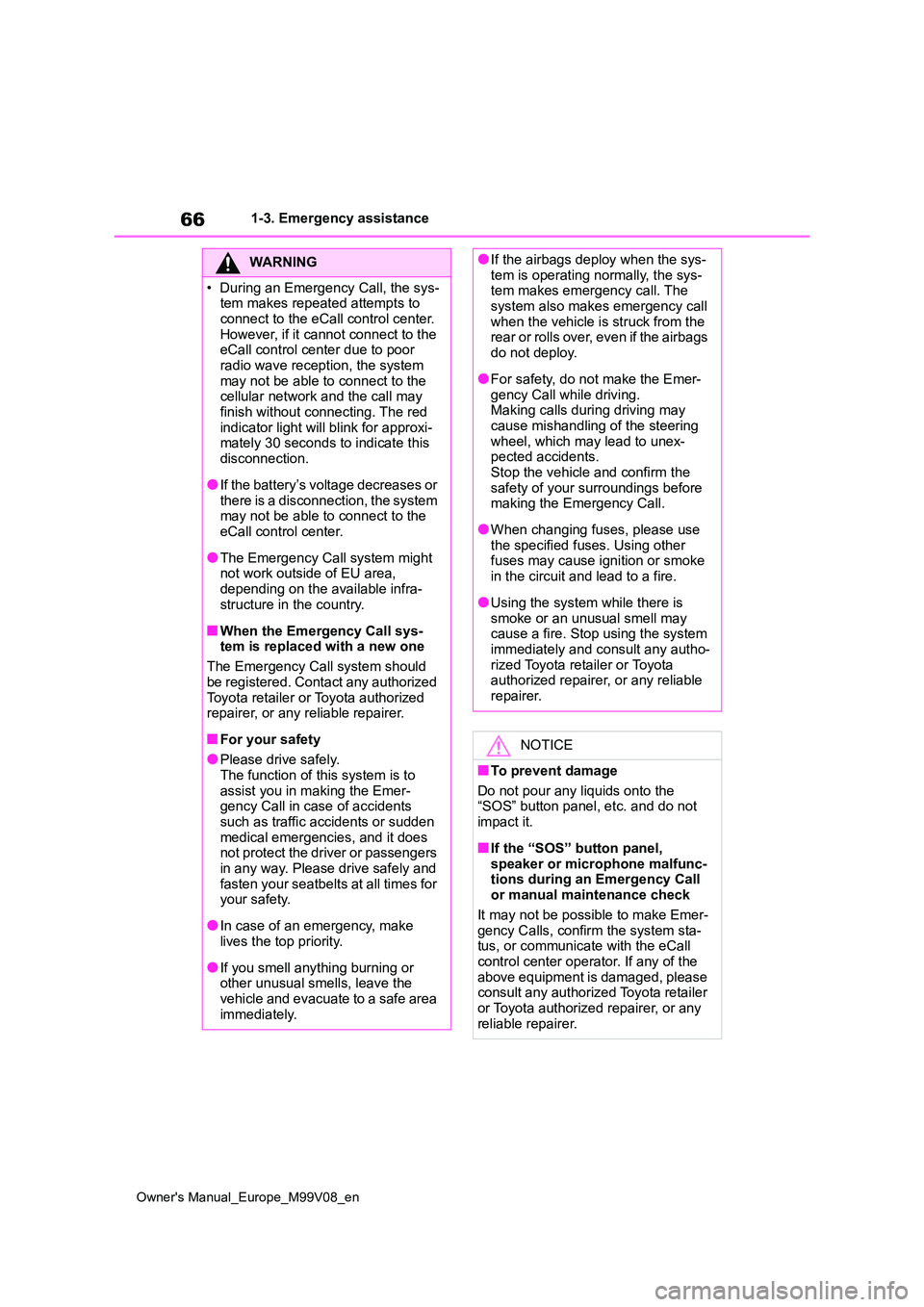
66
Owner's Manual_Europe_M99V08_en
1-3. Emergency assistance
WARNING
• During an Emergency Call, the sys- tem makes repeated attempts to
connect to the eCall control center. However, if it cannot connect to the eCall control center due to poor
radio wave reception, the system may not be able to connect to the cellular network and the call may
finish without connecting. The red indicator light will blink for approxi-mately 30 seconds to indicate this
disconnection.
●If t he b at t er y ’s vo lt a g e d ec r ea se s o r
there is a disconnection, the system may not be able to connect to the eCall control center.
●The Emergency Call system might not work outside of EU area,
depending on the available infra- structure in the country.
■When the Emergency Call sys-tem is replaced with a new one
The Emergency Call system should
be registered. Contact any authorized Toyota retailer or Toyota authorized repairer, or any reliable repairer.
■For your safety
●Please drive safely.
The function of this system is to assist you in making the Emer-gency Call in case of accidents
such as traffic accidents or sudden medical emergencies, and it does not protect the driver or passengers
in any way. Please drive safely and fasten your seatbelts at all times for your safety.
●In case of an emergency, make lives the top priority.
●If you smell anything burning or other unusual smells, leave the
vehicle and evacuate to a safe area immediately.
●If the airbags deploy when the sys-tem is operating normally, the sys-tem makes emergency call. The
system also makes emergency call when the vehicle is struck from the r e a r o r r ol l s ov er, ev e n i f t h e a ir b a gs
do not deploy.
●For safety, do not make the Emer-
gency Call while driving. Making calls during driving may cause mishandling of the steering
wheel, which may lead to unex- pected accidents.Stop the vehicle and confirm the
safety of your surroundings before making the Emergency Call.
●When changing fuses, please use the specified fuses. Using other fuses may cause ignition or smoke
in the circuit and lead to a fire.
●Using the system while there is
smoke or an unusual smell may cause a fire. Stop using the system immediately and consult any autho-
rized Toyota retailer or Toyota authorized repairer, or any reliable repairer.
NOTICE
■To prevent damage
Do not pour any liquids onto the “SOS” button panel, etc. and do not
impact it.
■If the “SOS” button panel,
speaker or microphone malfunc- tions during an Emergency Call or manual maintenance check
It may not be possible to make Emer- gency Calls, confirm the system sta-tus, or communicate with the eCall
control center operator. If any of the above equipment is damaged, please consult any authorized Toyota retailer
or Toyota authorized repairer, or any reliable repairer.
Page 72 of 494
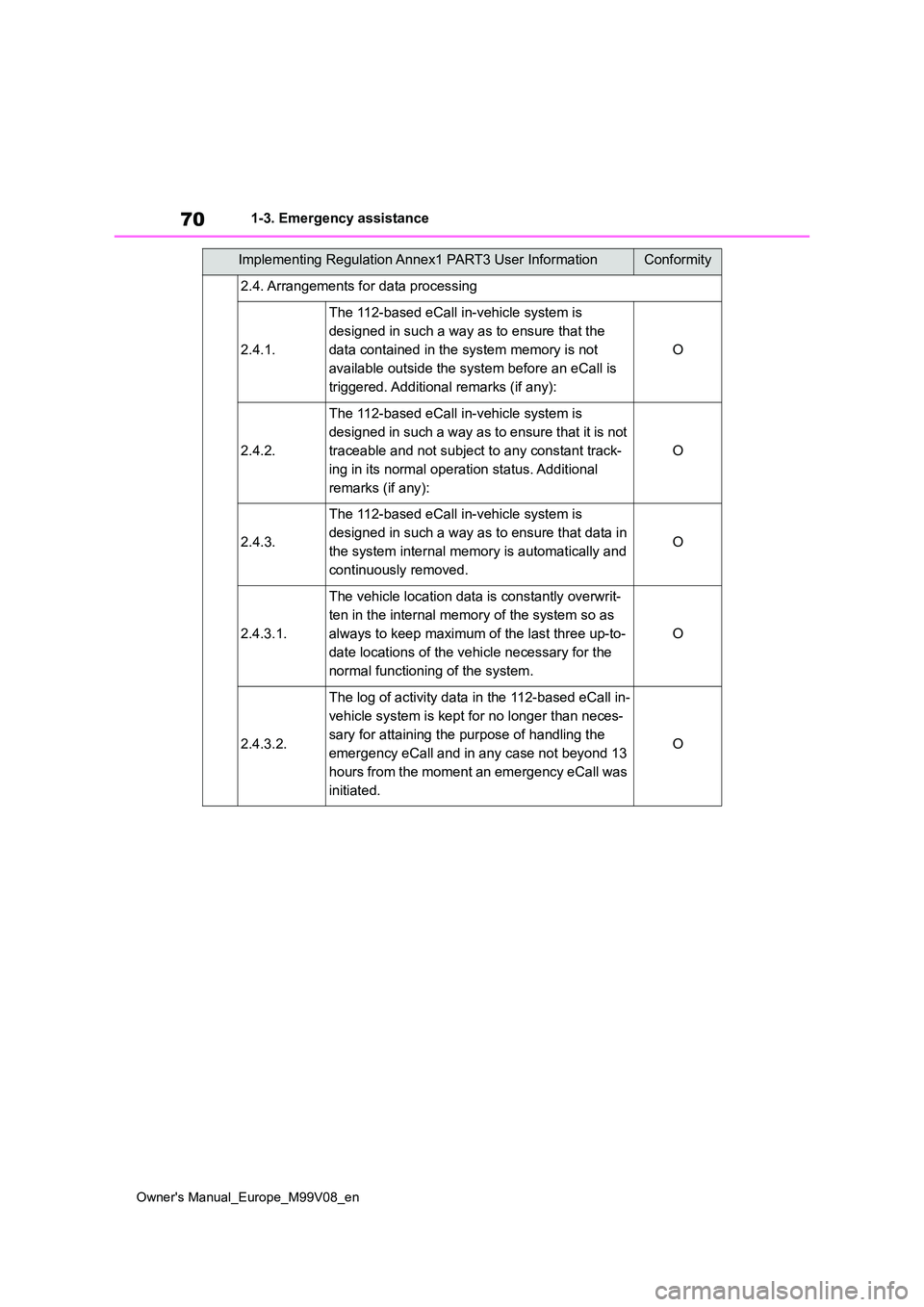
70
Owner's Manual_Europe_M99V08_en
1-3. Emergency assistance
2.4. Arrangements for data processing
2.4.1.
The 112-based eCall in-vehicle system is
designed in such a way as to ensure that the
data contained in the system memory is not
available outside the system before an eCall is
triggered. Additional remarks (if any):
O
2.4.2.
The 112-based eCall in-vehicle system is
designed in such a way as to ensure that it is not
traceable and not subject to any constant track-
ing in its normal operation status. Additional
remarks (if any):
O
2.4.3.
The 112-based eCall in-vehicle system is
designed in such a way as to ensure that data in
the system internal memory is automatically and
continuously removed.
O
2.4.3.1.
The vehicle location data is constantly overwrit-
ten in the internal memory of the system so as
always to keep maximum of the last three up-to-
date locations of the vehicle necessary for the
normal functioning of the system.
O
2.4.3.2.
The log of activity data in the 112-based eCall in-
vehicle system is kept for no longer than neces-
sary for attaining the purpose of handling the
emergency eCall and in any case not beyond 13
hours from the moment an emergency eCall was
initiated.
O
Implementing Regulation Annex1 PART3 User InformationConformity
Page 73 of 494
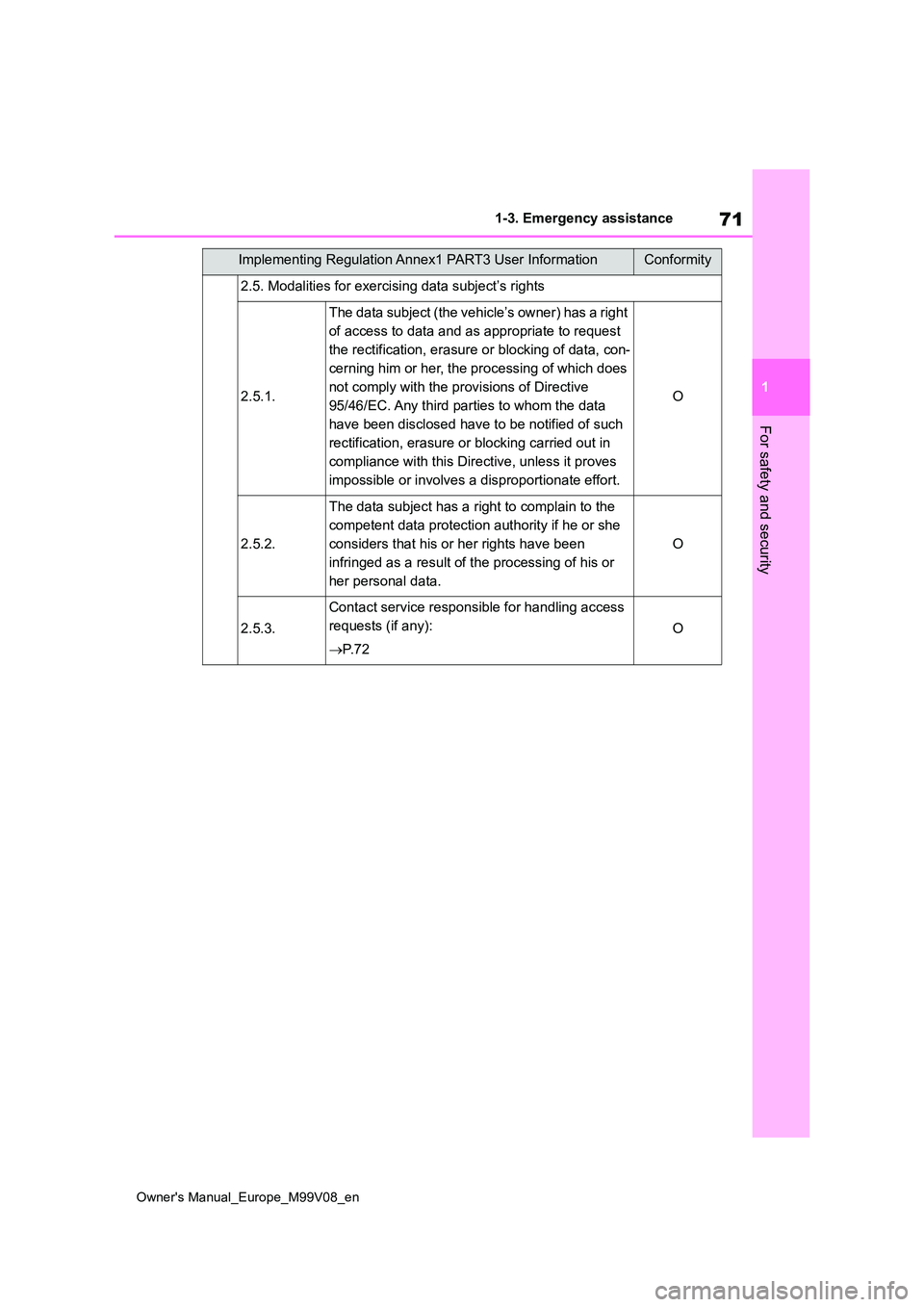
71
1
Owner's Manual_Europe_M99V08_en
1-3. Emergency assistance
For safety and security
2.5. Modalities for exercising data subject’s rights
2.5.1.
The data subject (the vehicle’s owner) has a right
of access to data and as appropriate to request
the rectification, erasure or blocking of data, con-
cerning him or her, the processing of which does
not comply with the provisions of Directive
95/46/EC. Any third parties to whom the data
have been disclosed have to be notified of such
rectification, erasure or blocking carried out in
compliance with this Directive, unless it proves
impossible or involves a disproportionate effort.
O
2.5.2.
The data subject has a right to complain to the
competent data protection authority if he or she
considers that his or her rights have been
infringed as a result of the processing of his or
her personal data.
O
2.5.3.
Contact service responsible for handling access
requests (if any):
P. 7 2
O
Implementing Regulation Annex1 PART3 User InformationConformity